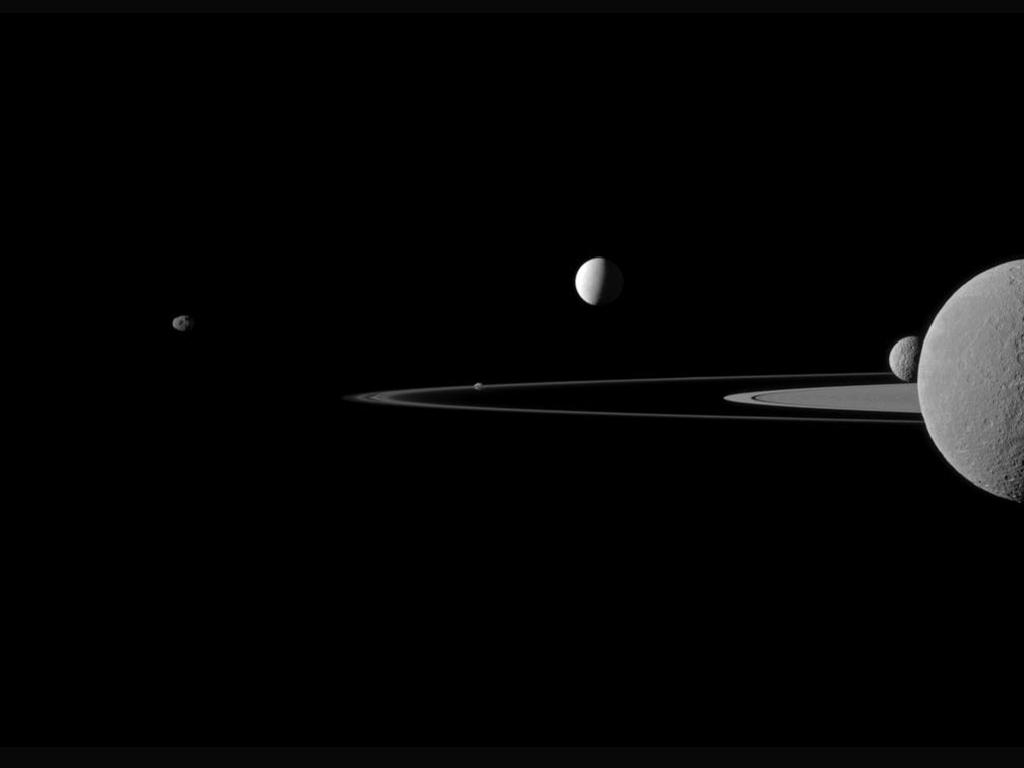Saturn's Rings & 5 Moons Shine Together in Spectacular New Photo

A stunning new photo from NASA's Cassini spacecraft shows five moons of Saturn hovering around two of the gas giant planet's dazzling rings.
The image, which NASA released Wednesday (Sept. 21), shows Saturn's moons Janus, Pandora, Enceladus, Mimas and Rhea. The planet's rings are beyond Rhea and Mimas, while bright Enceladus appears behind the rings. Cassini took the picture in visible green light on July 29, 2011. [See the amazing photo of Saturn's rings and moons]
The view looks toward the northern, sunlit side of the rings from just above the ringplane, researchers explained in a description.
The five Saturn moons in Cassini's photo vary greatly in size, with Pandora (50 miles wide, or 81 kilometers) and Janus (111 miles, or 179 km) the smallest. The "Death Star moon" Mimas measures 246 miles (396 km) across and Enceladus is 313 miles (504 km) wide. Rhea is Saturn's second-largest moon, at 949 miles (1,528 km) across.
In the image, Pandora appears near the center of the frame between Saturn's A ring and the thin F ring.
The Cassini spacecraft was closest to Rhea when it snapped the photo — about 684,000 miles (1.1 million km), researchers said. The spacecraft was 1.1 million miles (1.8 million km) from Enceladus, a frozen world that spouts water-ice geysers into space.
Saturn has more than 60 known moons. The largest, Titan, is about 3,200 miles (5,150 km) wide, making it nearly 50 percent bigger than Earth's moon. [Photos: The Rings and Moons of Saturn]
Get the Space.com Newsletter
Breaking space news, the latest updates on rocket launches, skywatching events and more!
NASA launched Cassini toward Saturn in 1997, and the spacecraft arrived at the ringed planet in 2004. Cassini has been circling the planet to study its rings and moons ever since. Cassini also carried the European Huygens lander, which touched down on Titan in 2005.
Cassini's mission was originally slated to end in 2008, but NASA has extended the Saturn flight twice, most recently until 2017. The Cassini mission is a cooperative effort by NASA, the European Space Agency and the Italian space agency.
Follow SPACE.com for the latest in space science and exploration news on Twitter @Spacedotcom and on Facebook.
Join our Space Forums to keep talking space on the latest missions, night sky and more! And if you have a news tip, correction or comment, let us know at: community@space.com.

Space.com is the premier source of space exploration, innovation and astronomy news, chronicling (and celebrating) humanity's ongoing expansion across the final frontier. Originally founded in 1999, Space.com is, and always has been, the passion of writers and editors who are space fans and also trained journalists. Our current news team consists of Editor-in-Chief Tariq Malik; Editor Hanneke Weitering, Senior Space Writer Mike Wall; Senior Writer Meghan Bartels; Senior Writer Chelsea Gohd, Senior Writer Tereza Pultarova and Staff Writer Alexander Cox, focusing on e-commerce. Senior Producer Steve Spaleta oversees our space videos, with Diana Whitcroft as our Social Media Editor.








